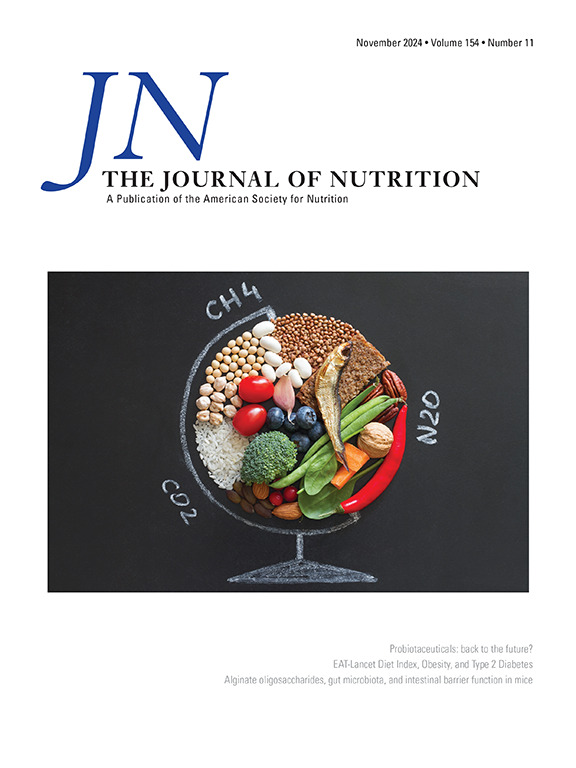Processing of Dairy Products Can Affect the Digestible Indispensable Amino Acid Score (DIAAS): An In Vivo Study in Bama Minipigs
IF 3.8
3区 医学
Q2 NUTRITION & DIETETICS
引用次数: 0
Abstract
Background
During manufacturing, different applied processes can potentially alter macro- and microstructures of milk proteins, which eventually affect the digestibility and the digestible indispensable amino acid score (DIAAS).
Objectives
We aimed to investigate the effects of different processes, including heating and fermentation, on the ileal digestibility of amino acids (AA) and DIAAS in dairy products.
Methods
Six dairy products were produced under different processing conditions. Seven ileal cannulated Bama minipig (initial body weight: 20.0 ± 0.8 kg) were assigned to a 7 × 6 incomplete Latin square design, which incorporated 7 diets (6 dairy products and 1 nitrogen-free diet) and 6 7-d periods. Ileal digesta were collected for 9 h (from 08:00 to 17:00) on days 6 and 7 of each period. The content of crude protein (CP) and AA was determined. True ileal digestibility (TID) and DIAAS were calculated. One-way analysis of variance was used to evaluate the significant differences.
Results
The TID of CP was 97.0% ± 1.6%, 98.7% ± 1.8%, and 100.7% ± 0.5% (mean ± standard error of the mean) for raw milk (RM), pasteurized milk (PM), and high temperature treated milk (HTM). The TID of methionine was lower (P = 0.050) for the pasteurized yogurt with pectin addition (PYP, 97.6% ± 0.4%) compared with that in the nontreated yogurt (NTY, 99.5% ± 0.5%) and pasteurized yogurt (PY, 99.5% ± 0.3%). Regarding DIAAS results, the quality of proteins in the studied products was predominantly classified as “excellent” and partially as “good.” For individuals older than 3 y, the DIAAS were 112, 123, 104, 110, 110, and 120 for RM, PM, HTM, NTY, PY, and PYP.
Conclusions
Although different processes could alter the values of TID and DIAAS, the protein quality in the studied dairy products still remained as high. Milk protein from each of the dairy products can be highly utilizable if ingested alone.
乳制品加工对巴马猪体内可消化氨基酸评分(DIAAS)的影响
背景:在生产过程中,不同的应用工艺可能会改变牛奶蛋白质的宏观和微观结构,最终影响牛奶的消化率和可消化必需氨基酸评分(DIAAS)。目的:研究加热和发酵等不同工艺对乳制品中氨基酸(AA)和DIAAS回肠消化率的影响。方法:在不同的加工条件下生产6种乳制品。选取7头初始体重为20.0±0.8 kg的回肠空心巴马迷你猪,采用7×6不完全拉丁方试验设计,分为7种饲粮(6种乳制品和1种无氮饲粮)和6个7 d试验期。在每一期的第6天和第7天(08:00 ~ 17:00)收集9 h的回肠食糜。测定粗蛋白质(CP)和氨基酸的含量。计算真回肠消化率(TID)和DIAAS。采用单因素方差分析评估显著性差异。结果:原料乳(RM)、巴氏灭菌乳(PM)和高温处理乳(HTM)中CP的TID分别为97.0±1.6%、98.7±1.8%和100.7±0.5%(平均±SEM)。与未处理酸奶(NTY, 99.5±0.5%)和灭菌酸奶(PY, 99.5±0.3%)相比,添加果胶的巴氏酸奶中蛋氨酸的TID (PYP, 97.6%±0.4%)较低(p = 0.050)。关于DIAAS结果,所研究产品中的蛋白质质量主要被评为“优秀”,部分被评为“良好”。3岁以上个体RM、PM、HTM、NTY、PY和PYP的DIAAS分别为112、123、104、110、110和120。结论:虽然不同的加工工艺会改变乳制品中TID和DIAAS的值,但所研究的乳制品中的蛋白质质量仍然很高。如果单独摄入,每种乳制品中的乳蛋白都可以被高度利用。
本文章由计算机程序翻译,如有差异,请以英文原文为准。
求助全文
约1分钟内获得全文
求助全文
来源期刊

Journal of Nutrition
医学-营养学
CiteScore
7.60
自引率
4.80%
发文量
260
审稿时长
39 days
期刊介绍:
The Journal of Nutrition (JN/J Nutr) publishes peer-reviewed original research papers covering all aspects of experimental nutrition in humans and other animal species; special articles such as reviews and biographies of prominent nutrition scientists; and issues, opinions, and commentaries on controversial issues in nutrition. Supplements are frequently published to provide extended discussion of topics of special interest.
 求助内容:
求助内容: 应助结果提醒方式:
应助结果提醒方式:


